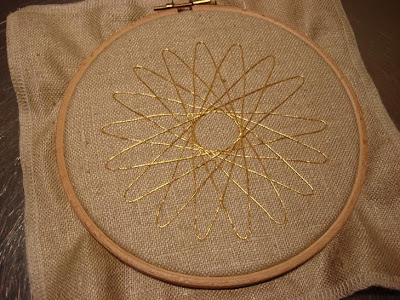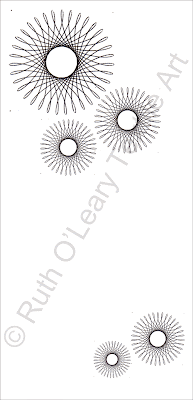On the face of it, they look much the same, but I need to make a decision on which one to use. Looking at the pros and cons of each:-
Linen pros:
- Easier - doesn't require stitching through from the back as the transfer's on the front.
Linen cons:
- As the transfer's on the front, it's still visible in places unless I'm very accurate
- Even if I am, transfers still smudge when you iron them on sometimes, and the bigger the transfer, the greater the chances of smudging.
Silk pros:
- Any design lines left over can be picked out.
Silk cons:
- Will take quite a lot longer, as the transfer will need to be stitched through from the back.
So, the obvious conclusion is to use the linen, and take extra care when applying the transfer. So you won't be too surprised to hear that I'm going for the silk!
Partly this is to get round any potential problems with the transfer, but if I'm honest, it's mostly because I just like it better. I love the way that it has a rough, coarse appearance, but is actually beautifully soft, and lovely to work with. I think it gives a nice contrast to the smooth gold thread, and even if some of the design-transferring stitches are still visible when I'm finished (most likely round the centre, if my test piece is anything to go by), then the orangey thread gives a warm hint to it, rather than the cool blue of any visible transfer pencil.
Yes, I know it's going to take me twice as long to do, but I don't care. It's how I want to do it. I've ordered the fabric.
One more quick test: when couching the gold thread, I only stitched over it at the points where threads crossed, so that the main lengths were smooth and unbroken. Unfortunately, this led them to wiggle slightly; stretching them onto some mount board solved that, but I'll be making hangings, which won't be stretched, so that's not going to help, and nor is the fact that most of the Spirograph designs are a lot bigger than this. They need to be stitched down far more frequently. But I still want the smooth unbroken look. This is a problem.
As a test, I've tried couching some gold passing thread with 'invisible' nylon thread. I've never used this before so how come I have a reel of it in my thread stash I don't know, but here's how the experiment looked:
This is exactly the look I'm after, but there is a downside: this thread is horrible to work with, it really is. It's not thread at all, it's a very fine plastic wire, and I hate it. So I now have to decide whether to go for the look I want and use the nasty nylon stuff or sacrifice some of the smoothness and use normal thread. I really don't know which way to go on this one.

























